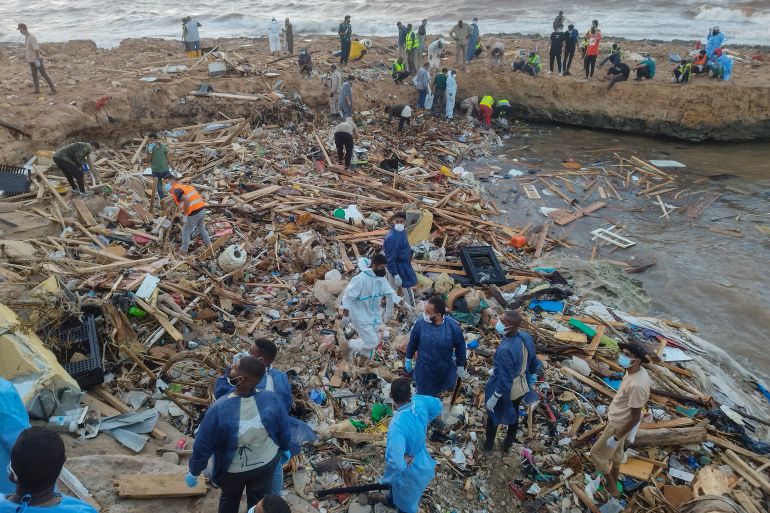Health officials warn of the danger of water contamination in the aftermath of catastrophic floods in Libya’s east.
 Rescuers and relatives search for bodies of victims in Derna [File: Abdulaziz Almnsori/AP Photo]
Rescuers and relatives search for bodies of victims in Derna [File: Abdulaziz Almnsori/AP Photo]By Kim Makhlouf
Published On 20 Sep 202320 Sep 2023
More than a week after floods caused by Storm Daniel devastated eastern Libya, killing thousands and displacing many more, survivors are faced with another threat: water contamination.
Health authorities have been sounding the alarm over the spread of waterborne diseases in the affected areas, particularly in the hard-hit city of Derna.
KEEP READING
Flooding death toll soars to 11,300 in Libya’s coastal city of Derna
‘Desert turned into a sea’: Eastern Libya flood survivors recount horror
Experts have warned that floodwaters have severely contaminated water sources with sewage, rendering them unsafe for consumption and exposing communities to grave health risks.
Here are the answers to some key questions about the situation.
What is water contamination?
Water contamination occurs when germs and chemicals enter drinking water at its source – for example, groundwater or water from lakes or rivers – or during water’s course through a distribution system.
According to the World Health Organization (WHO), contaminated water and poor sanitation are linked to the transmission of diseases such as cholera, diarrhoea, dysentery, hepatitis A, typhoid and polio.
How is the problem dealt with in crisis-hit areas?
Essentially, through a combination of short-term and long-term measures, said Jessica Moussan, spokesperson for the International Committee of the Red Cross.
The first step, Moussan explained, is to provide water that is safe for consumption – whether it is for drinking, cooking or hygiene purposes.
In the long run, the focus is mainly on repairing necessary infrastructure, in addition to other measures that include the chlorination of public water sources and the dissemination of information on safe water practices.
What is the scale of water contamination in Libya?
Libya has been mired in political turmoil and fighting since the removal of longtime ruler Muammar Gaddafi in 2011. The country has been run for nearly a decade by two feuding entities divided between western and eastern Libya, each backed by different militias. This has left its infrastructure in tatters, making it more vulnerable to disasters.
Moussan said the recent floods have caused severe disruptions, including to the water infrastructure, which “further compound [the country’s] challenges”.
While specific figures are hard to come by, the effect of the disaster on sewage systems means that there is “an elevated risk of the population coming into contact with unsafe water”, she added.
According to the United Nations Office for the Coordination of Humanitarian Affairs, at least 150 people have become sick due to water contamination in the 10 days since the flooding, including some 55 children in Derna.
“The situation in Derna and other flood-affected areas of Libya is dire,” the International Rescue Committee (IRC) said in a statement. “Access to clean water is a basic human right, and we are deeply concerned about the health and well-being of those affected by this contamination crisis.”
How is it being dealt with?
Several local and international aid groups, including the Libyan Red Crescent and UN agencies, have responded to the disaster by providing immediate relief efforts.
The response has ranged from evacuating stranded residents and providing medical aid and essential supplies to securing safe water and sanitation equipment in order to prevent diseases from taking hold.
Humanitarians have also appealed for additional funding to scale up operations response and reach more affected residents in Derna and its surrounding areas.
No comments:
Post a Comment